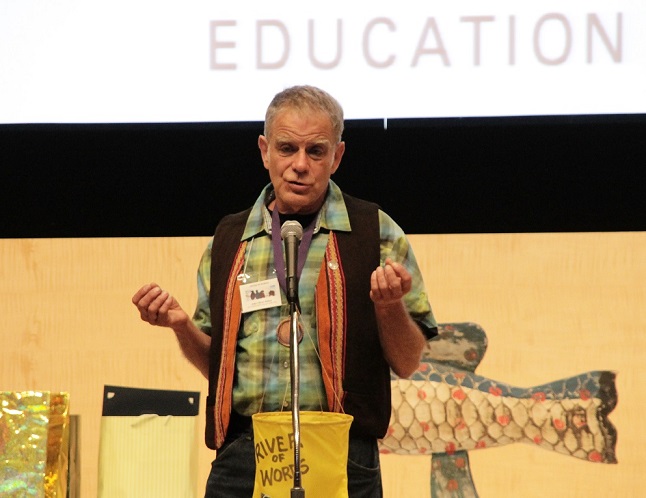As a professor of language and literacy education as well as a poet, it has long been my goal to train educators to be teaching artists in the classroom, able to engage in creative and playful approaches to curriculum and instruction in languages, literatures, and creative writing.
In 2017 I had the opportunity to put a creative teacher education curriculum into practice when I became the Richard Ruiz Scholar/Artist in Residence in Guanajuato, Mexico, where I worked with a group of pre-service teachers from the University of Arizona who were studying there for the summer. Having written about Mexico and Mexican immigration to the US for many years, I was eager to share the ways in which poetry writing helps to clarify the feelings of displacement, anxiety, wonder, and curiosity that can occur when we cross thresholds of language, culture, nation, and race.
The poetry assignments I designed were meant to help the teachers use writing to navigate their emotional and sensory responses to their experiences in Mexico. One student in the program was a Mexican national and six of the nine were of Mexican heritage. All nine students described themselves as language learners of one kind or another in Mexico, acquiring proficiency in academic Spanish as well as the languages associated with the education fields in which they were training (math, special education, language education, psychology). None of these participants indicated they had much, if any, previous creative writing experience in English or Spanish.
In one of my first poetry invitations to the students, I asked them to document, in writing, their sensory observations of Mexico for two weeks, in the spirit of WC Williams’ famous line from Paterson, “no ideas but in things”:
—Say it, no ideas but in things—
nothing but the blank faces of the houses
and cylindrical trees
bent, forked by preconception and accident—
split, furrowed, creased, mottled, stained—
secret—into the body of the light!
My instructions were as follows:
We are all documenting our stay in Mexico with a camera, but the lens can only capture part of what we experience. So this week I want you to use words as well. Take a few minutes each day to describe in writing what you see in Mexico. Keep it simple and as full of concrete, sensory detail as possible. If you saw a blue bird, then try to find out the name of the bird, describe something about it—what it was doing, how might you describe the comb on its head, its beak. Try to resist using language that we expect; e.g., “a beautiful bird.” Resist metaphor. Just write what you see, as you see it, in concrete, image-rich language. Bring to class one copy of all the observations you make throughout the week.
This assignment is a variation on those I learned from two accomplished poets and teachers, Anne Waldman and Marie Howe. Howe discussed this assignment with Krista Tippett on her radio show, “On Being,” and this conversation became another resource for our class.
One of my students, Caitlin, remarked how this exercise in noticing helped her go beyond “having fun” toward a more meaningful reflection that felt new to her: “Writing poetry has been making me more reflective about the things I’ve been doing. Normally when I go on vacation I just kind of do it and I come home and think, “Oh I had fun!” But writing the poems and [journaling] is making me get more out of [this experience].”
Many students, like Emilia, wrote observations about their homestay experiences, which elevated their sensory appreciation of this new context. Here are a few lines from Emilia’s poem about the “Casa de Sra. Caballeros.”
Deep sleep, my eyes open, focusing on orange cream-colored walls, the sound of Paco, the yellow-headed amazon parrot, slowly touching my ears.
Orange tile, the same color as papaya, glossier,
Square-shaped, using my slept in and tired legs, one by one down three papaya colored steps.…
The peaceful silence, slight sound of fire turned on in the black and white colored stove. I take my seat, there in front of me sits a tray of different kinds of pan dulce: the conchas, the bolillos, the donut in the tray’s corner, with beautiful milk chocolate covering the round, sweet bread’s top.
As students continued to document sensory images in free verse drafts, I asked them to use their observations to create poems using traditional verse structures such as the villanelle, a form that requires three line stanzas that repeat the first and third lines and rhyme the second lines throughout the entire length of a six-stanza poem. I gave them examples such as Elizabeth Bishop’s poem “One Art” and more contemporary poems such as David Trinidad’s “Chatty Cathy Villanelle.”
Writing in a given poetic form gave my students the chance to take their observations of daily life in Mexico and imbue them with meaning. Caitlin used the form to answer the question posed by a commonly heard phrase in Mexico. She said that every day, her host mother would ask her, “¿Cómo les fue?” [How did it go?]. Limited by her Spanish language skills, Caitlin always answered with one word “bien” [well], unable to provide more complete or nuanced answers about her feelings and experiences. The poem gave her a place to articulate what she wished she could say. Caitlin drew on her emergent bilingual literacies to express her appreciation for the experiences she was having in Guanajuato, but also her longing for people and places back home.
Homestay Question
by Caitlin Welty“¿Cómo les fue?”
Bien, sparkling turquoise water warmed my muscles, although,
I miss you every day.Seared into my brain, “cinco, seis, siete”
Dancing in a tangle of arms, yet the steps flow.
“¿Cómo les fue?”I hear the whisper of a familiar song, stay
a little longer and help me forgo
the thoughts of you every day.A stroll through the alleys made my worries fade away,
Vendors all around, but they come and go.
“¿Cómo les fue?”A teacher expressing his frustration with the school system, which makes him say,
All students should feel valued y contento
I strive for that every day.I don’t want to leave, I want to stay
in my new found home, Guanajuato.
“¿Cómo les fue?”
I miss you every day.
Learning new and different ways to “see” what is all around us was a major focus of our poetry-writing course. Two of my teacher/students, Grissel and Joselin, talked about how the writing they did not only helped awaken their sensory perception, but also allowed them to learn about Guanajuato from their peers’ poems. They both described how reading one another’s poems heightened their awareness, calling their attention to sights and sounds they may have previously overlooked. As Grisell said, “It’s like I’m feeling what [my peers] are feeling through their lenses.”
Writing poems also helped these young teachers-in-training learn to see their new surroundings with a greater depth of understanding. Marley discussed how her writing helped her see her relative economic privilege compared to the laborers she observed in Mexico City, where the group stayed for the first days of their study abroad. Her poem below was inspired by a Theodore Roethke poem, “Dolor.” Students were asked to imitate Roethke’s first line: “I have known the inexorable sadness of pencils,” concretizing an abstract emotion through careful description of objects in a specific place. Marley wrote about the streets of Mexico City as a way to show compassion for the hard-working people who routinely care for the urban place and its people.
Wake up and Repeat
by Marley Angelita MurrellI have known the overwhelming exhaustion of streets,
Broken and uneven just like the soles of my feet.
The tiredness treads time like thieves,
Smells of elotes, horchata, and carne asada linger in the air,
Carts compacted compiling the calle,
Beautiful silver jewelry and dulces of pinks and golds
Early morning workers arise before the sun
The early bird gets the pesos.
And the palms of their hands tell many stories,
Each wrinkle and crack was not earned easily.
Backs ache but their minds stay focused
Each sunrise brings a new day but work stays a routine,
Wake up and repeat
Wake up and repeat
There is something special about keeping things the same.
As a group, we discussed the way Marley and other students incorporated the lexicon and grammar of Spanish into the English worlds of their poems, and how their own bilingual identities as well as those of their future K-12 students might be honored through verse. My hope is that these new teachers will approach their K-12 classrooms in the US as if these places, too, are new countries, observing and documenting with wonder and care what their students bring to their classrooms.
In another poetry assignment, I asked the students to write in the voice of a non-human object. Joselin chose to write in the voice of the stuffed “Dumbo” she’d brought with her to Guanajuato. We all marveled at the way her poem gave voice to her hybrid, bilingual-bicultural identity.
“Doom-bo” Speaks
by Joselin TamayoThe years are piling up. I’m not the same as when she first saw me.
My fluff, my thickness, my softness, all changed.
Now, scars adorn my body;
injuries and surgeries done to fix my appearance
and keep me from ripping apart.I spend my days on the bed.
Waiting for warm hugs and nose kisses,sentir su cabeza pesada sobre mí.
Me encanta poder ser ese apoyo suave en las noches, y cuando se relaja.
Estar ahí cuando los días son tristes y ella necesita a un amigo que seque sus lágrimas.Oh Look! I guess it’s time for a shower!! We both know I need it.
Into the washer I go!Ahora si, A oler rico y fresco!
La secadora es mi parte menos favorita.
Too HOT!I see maletas!
Solo me queda preguntar,
Where are we going now?¿Que nueva aventura nos espera?
Guanajuato? Reno? New York?
I’ve seen and lived so much in such a short life.
Met new people, traveling in a backpack by plane, by car, by bus,Feeling loved and appreciated everywhere I go.
Emocionado al pensar en las nuevas aventuras que la vida tiene preparado para mí
a lado de mi amada.
Among the many joys I experienced teaching poetry abroad was having the opportunity to participate in the assignments alongside the teacher/students in my class. Each poetry invitation I gave to these students I also accepted myself. I believe that this nurtured an atmosphere of trust, and allowed my students to be vulnerable, to take risks in their writing. One biracial student wrestled with the way Mexicans seemed always to be represented as white in advertisements. Another student told us how she secreted a hearing aid behind her long dark hair. Still another wrote about a sister who struggled with a life-threatening illness. Poetry helped create a classroom of dialogue and shared observations.
As I shared my own new poem drafts with my students, I hoped to model a “teacher-artist” identity as well as “teacher-learner” identity. Just as artists and teaching artists in Mexico often work together in “talleres” or “artist workshops,” so too I wished for US teachers to see themselves as co-learners and co-creators in their K-12 classrooms, working alongside students on reading and writing with personal investment.
Many of us in the US, including teachers, occupy the spaces between languages, cultures, races, and nations. It is my hope that more teachers can explore this fertile “in-between” territory with their students, modeling what it means to be open and curious, to take risks as writers, and to listen to others. If writing poetry can help teachers develop meaningful and personal literacy practices, then perhaps these future literacy teachers will be better equipped to help their own students to do the same.
For Further Reading:
- Glossary terms and examples of ghazal verse form
- Agha Shahid Ali’s poem “In Arabic” (a ghazal) http://www.ronnowpoetry.com/contents/ali/InArabic.html
Melisa Cahnmann-Taylor, professor of language and literacy education at the University of Georgia, is the author of Imperfect Tense (poems) and three scholarly books in education. Winner of NEA “Big Read” Grants, the Beckman award for "Professors Who Inspire," and a Fulbright for a nine-month study of adult Spanish language acquisition in Oaxaca, Mexico, she judges the annual ethnographic poetry competition for Anthropology & Humanism. Her work has appeared in Georgia Review, American Poetry Review, Women’s Quarterly Review, Cream City Review, Barrow Street, and many other literary and scholarly homes. She posts at her blog, teachersactup.com.




2 responses to “Teachers as Poets”
Wow! Very insightful reading. As teacher and literacy enthusiast, I found the ideas presented to be not only very creative, but able to fire the imagination. Heightened sensory perception and curiosity about ones surrounding will definitely be a result of such literary explorations. Well done. teachers!
Thank you Vee!